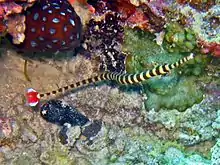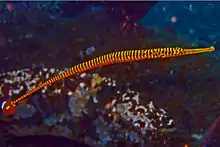Dunckerocampus
Dunckerocampus is a genus of pipefishes one of two genera known as the flagtail pipefishes. This genus is native to the Indian and Pacific Oceans where they are usually found in reef environments. These species are elongated and have a maximum length between 10 and 20 centimetres (3.9 and 7.9 in), with D. chapmani being the only species with a maximum length below 15 centimetres (5.9 in). Their tail is red with a whitish edge, and in some species there is a white or yellow spot in the center. All except D. baldwini have vertical red/brown and yellow/white stripes on their body.

Broad-banded Pipefish (D. boylei)
| Dunckerocampus | |
|---|---|
 | |
| Ringed Pipefish (D. dactyliophorus) | |
 | |
| Yellow-banded Pipefish (D. pessuliferus) | |
| Scientific classification | |
| Kingdom: | Animalia |
| Phylum: | Chordata |
| Class: | Actinopterygii |
| Order: | Syngnathiformes |
| Family: | Syngnathidae |
| Subfamily: | Syngnathinae |
| Genus: | Dunckerocampus Whitley, 1933 |
| Type species | |
| Syngnathus dactyliophorus Bleeker, 1853 | |
Species
There are currently seven recognized species in this genus:[1]
- Dunckerocampus baldwini Herald & J. E. Randall, 1972 (Redstripe pipefish)
- Dunckerocampus boylei Kuiter, 1998 (Broad-banded Pipefish)
- Dunckerocampus chapmani Herald, 1953 (Glowtail pipefish)
- Dunckerocampus dactyliophorus (Bleeker, 1853) (Ringed pipefish)
- Dunckerocampus multiannulatus (Regan, 1903) (Many-banded pipefish)
- Dunckerocampus naia G. R. Allen & Kuiter, 2004
- Dunckerocampus pessuliferus Fowler, 1938 (Yellowbanded pipefish)
References
- Froese, Rainer and Pauly, Daniel, eds. (2012). Species of Dunckerocampus in FishBase. October 2012 version.
This article is issued from Wikipedia. The text is licensed under Creative Commons - Attribution - Sharealike. Additional terms may apply for the media files.